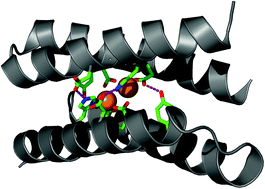Intelligent design: the de novo engineering of proteins with specified functions
Abstract
One of the principal successes of de novo protein design has been the creation of small, robust protein-cofactor complexes which can serve as simplified models, or maquettes, of more complicated multicofactor protein complexes commonly found in nature. Different maquettes, generated by us and others, recreate a variety of aspects, or functional elements, recognized as parts of natural enzyme function. The current challenge is to both expand the palette of functional elements and combine and/or integrate them in recreating familiar enzyme activities or generating novel catalysis in the simplest protein scaffolds.


 Please wait while we load your content...
Please wait while we load your content...